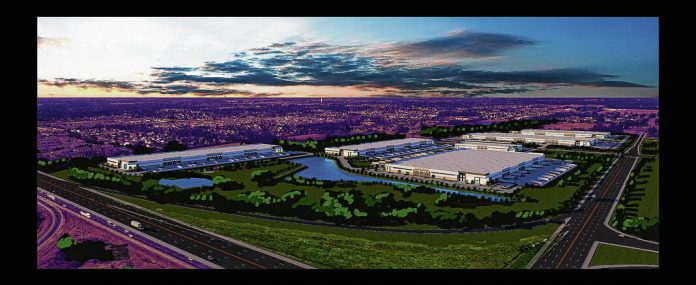A pair of local developers planning to spend $175 million to create an industrial park on the south side of Indianapolis is seeking a property tax break from the city that could save them $7.56 million over five years.
Indianapolis-based firms Gershman Partners and Citimark, through holding company GP-CM County Line Partners LLC, plan to break ground in early 2024 on their project on the northeast and northwest corners of the intersection of South Arlington Avenue and County Line Road.
Built primarily on what is now agricultural land, the 1.9 million-square-foot project is expected to encompass 170 acres and consist of five buildings, ranging from 100,000 square feet to nearly 575,000 square feet.
The project, tentatively named the I-65 & County Line Road Industrial Park, would also include 6.4 acres of commercial and retail space at the northwest corner of County Line Road and Arlington Avenue, with at least two outlots available for lease and room for a small shopping center, depending on market demand.
“We see this as an infill industrial location that has excellent access to a strong labor pool, helping us attract businesses to Indianapolis,” said Ryan Gershman, a principal at Gershman Partners, who is leading the project. The project is Gershman Partners’ first foray into industrial development; Citimark has completed several industrial projects.
According to filings with the city’s Department of Metropolitan Development, the buildings would be freestanding, divisible structures of the following sizes:
— Building 1, 344,100 square feet
— Building 2, 324,000 square feet
— Building 3, 573,192 square feet
— Building 4, 101,640 square feet
— Building 5, 553,660 square feet
The industrial park is expected to be developed in phases, completed by 2030. Gershman said some of the buildings could change in size, depending on tenant needs. The park will feature a mix of speculative and build-to-suit projects. He said he expects many of the buildings to be subdivided to accommodate multiple users.
“We see this as having a good mix of local, regional and national businesses. And with the buildings being divisible, it allows us to be flexible on the types of companies and businesses we attract,” Gershman said.
The investment in the industrial portions of the site is expected to be $126 million, but land acquisition, retail development and site and road infrastructure costs are expected to balloon that figure to $175 million.
The firms are seeking a five-year property tax abatement from the city of Indianapolis for the buildings, with the abatement percentage declining by 20% each year. The starting wage is required to be $18 per hour—a stipulation instituted by the city in mid-2019. The park is expected to employ at least 369 people by the time the final building is completed.
Over the life of the five-year abatement, GP-CM County Line Partners LLC would save $7.56 million—or 62% of their total tax liability—on their new investment in the site. The entity would still pay about $4.56 million in property taxes on the new development during that time, in addition to the $29,764 in tax already assessed on the property.
In their commitment to the city, the developers have agreed to target tenants that fall under the category of “opportunity industries,” defined as those that provide opportunities for worker advancement without requiring a bachelor’s degree.
If Gershman Partners and Citimark succeed in leasing at least 51% of the gross leasable area of any building to “opportunity industry” tenants, the abatement term for that building can be extended by two years. If all five buildings meet that requirement, the developers would reap an additional $1.94 million in tax savings. The companies would still pay about $2.87 million in real property taxes during the extended term.
After the tax abatement expires, GP-CM is expected pay an estimated $2.5 million in real property taxes annually on the new improvements.
Department of Metropolitan Development staff is recommending approval of the abatement, which will be considered by the Metropolitan Development Commission on Wednesday.
The MDC will also consider a proposal to designate the development site as an Economic Development Area, which would allow the city to capture the unabated portion of the increased property taxes from the project to finance public infrastructure improvements. Those projects would include widening parts of Arlington Avenue and improving the Arlington and County Line Road intersection.
A rezone of the site to allow for commercial and industrial development was approved by the MDC in October. The project was staunchly opposed by many neighbors, with about 40 expressing concerns over the project in writing—particularly about the project’s proximity to several residential neighborhoods just a few hundred feet away.
Gershman said larger buffer zones, totaling 10 acres with screening and landscaping, have been designed to minimize the effects of noise and light pollution on those subdivisions.
“It was important for us to engage with the local stakeholders, so we had a lot of meetings with different neighborhood groups,” he said.
The industrial portions of the project are expected to be marketed by a third-party brokerage service, although no deal has yet been finalized. Gershman plans to market the commercial spaces itself.
California-based Ware Malcomb is the architecture firm on the project.
By Mickey Shuey of the Indianapolis Business Journal.





